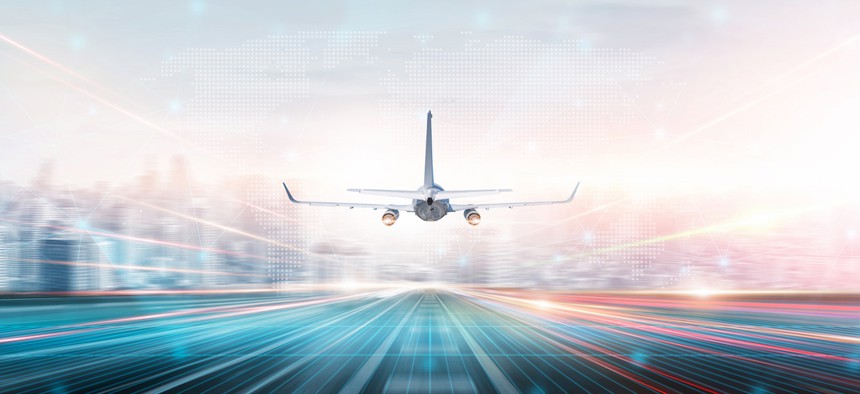Smarter local airports via digital twins

Tryaging/Getty Images
Digital twins can help airport planners effectively manage future renovation projects, monitor daily operations and visualize future scenarios.
Future airport and air transportation planning will become so complex that digital twins will be required to ensure the delivery of multiparty services, experts say.
With all the interdependencies across airport operations—such as terminal and airside operations, passengers and baggage, ground transport, air traffic control, cargo operations, safety and security—an airport is a complicated system of connected systems.
With digital twins running simulations of a system of systems model, “you can now expand your understanding and improve your decision-making,” said Isaac Benzaquen, global airport industry solution director at Dassault Systemes, a 3D and digital twin company. He spoke April 26 during a Digital Twin Consortium webinar titled “Composing Intelligent Transportation Hubs.”
When all the infrastructure is virtually connected to create a system, “then we can really look and simulate the flow, how the interaction of the flow between all these modes is going to happen,” Benzaquen said.
He walked through a research project in France that is analyzing whether small city airports could connect easily to large international ones. Officials created a system of systems to understand the effects on cities of small airports and vertiports, which are hubs for air taxis and drones.
“We can really understand … how everything is interacting within the vertiport,” Benzaquen said. The model allows users to see how the vertiport interacts with the cities or a nearby airport. Connecting all these systems to create a huge system of systems, allows planners to “define the optimal configuration of an airport or vertiport,” he said.
For instance, researchers can run scenarios to see what happens if they add another landing pad—how that changes costs to the city and the number of passengers who could be accommodated. “Also, I can inject [in]to the system different types of transportation,” he added. “Having a system approach gives you a great understanding from a logical and functional perspective how the system behaves, and you can run a lot of simulations.”
In addition to using a digital twin system of systems model to predict future mobility, it can also iterate, enhance and optimize the performance of assets, said Corey Gray, global chief executive officer at the Smart Cities Council.
To illustrate that, he pointed to Poland’s Centralny Port Komunikacyjny (CPK), a planned transfer hub between Warsaw and Łódź that will integrate air, rail and road transportation.
“The integrated passenger transport model is an example of exactly what we’re doing,” Gray said. “It’s allowing the people that are designing and delivering this project to access real data, event-driven data, and to understand the consequences of the design approaches that are taken…. By having a data-rich and living model, the project designers can reliably model, for example, the vertiports, model different systems, model different passenger and freight loads, and balance them all out to provide an ideally optimized outcome.”
Artificial and design intelligence play critical roles in this, but he said one result of the CPK project could be the emergence of machine teaching, or the control of machine learning so that the algorithms deliver the most relevant output. “If we have a standardized model for airports and we have interoperability and cybersecurity data exchange, we can with extreme precision, provide information from one asset to another, potentially to allow mistakes to be avoided or assumptions to be validated as we go forward,” he said.
Last September, TM Forum announced that it was working with the Airports Council International and the Digital Twin Consortium on the rapid prototyping of a proof of concept for smart airports. Using digital twins, the entire experience of air transportation “can be modeled and tested—even the mood of the traveler.”
“Modeling and simulation is where you’re able to create real-time decisions that have high impact,” said Doug Migliori, head of composable industry solutions at Vantiq. “Digital twins are becoming part of every conversation.”
Stephanie Kanowitz is a freelance writer based in northern Virginia.





